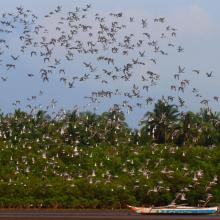

Negros Occidental Coastal Wetlands Conservation Area (NOCWCA)
- Country:Philippines
- Site number:2271
- Area:89,607.8 ha
- Designation date:20-10-2016
- Coordinates:10°15'N 122°46'E
Materials presented on this website, particularly maps and territorial information, are as-is and as-available based on available data and do not imply the expression of any opinion whatsoever on the part of the Secretariat of the Ramsar Convention concerning the legal status of any country, territory, city or area, or of its authorities, or concerning the delimitation of its frontiers or boundaries.
Overview
The Site lies along 110 kilometres of coastline of the island of Negros, covering 52 coastal districts (barangays), and three cities (Bago, Himamaylan and Kabankalan) and seven municipalities (Pulupandan, Valladolid, San Enrique, Pontevedra, Hinigaran, Binalbagan and Ilog). It hosts three globally threatened marine turtles, the critically endangered hawksbill turtle (Eretmochelys imbricata), the endangered green turtle (Chelonia mydas) and the vulnerable olive ridley turtle (Lepidochelys olivacea). The vulnerable Irrawaddy dolphin (Orcaella brevirostris) also inhabits the coastal areas. In 2014, 72 waterbird species were recorded in the NOCWCA, including the globally endangered great knot (Calidris tenuirostris), far eastern curlew (Numenius madagascariensis) and spotted greenshank (Tringa guttifer). There are three other vulnerable species: the Philippine duck (Anas luzonica) which is endemic to the Philippines, Chinese egret (Egretta eulophotes) and Java sparrow (Lonchura oryzivora). It is also known for its rich and diverse coastal resources, particularly mangroves and shellfish including economically important species such as oysters, green mussels (Perna viridis), nylon shell (Paphia undulata), angel wing shell (Pholas orientalis), shrimps and crabs. The Site faces potential threats including the conversion of mangrove forests and other wetlands to commercial or residential uses or for aquaculture, and also pollution by industrial waste and coliform contamination. Overfishing in some areas also threatens the biodiversity and the sustainability of local livelihoods.
Administrative region:
Negros Occidental, Negros Island Region
- Last publication date:19-10-2016
Downloads
Ramsar Information Sheet (RIS)
Site map
Additional reports and documents
- Taxonomic lists of plant and animal species occurring in the site
